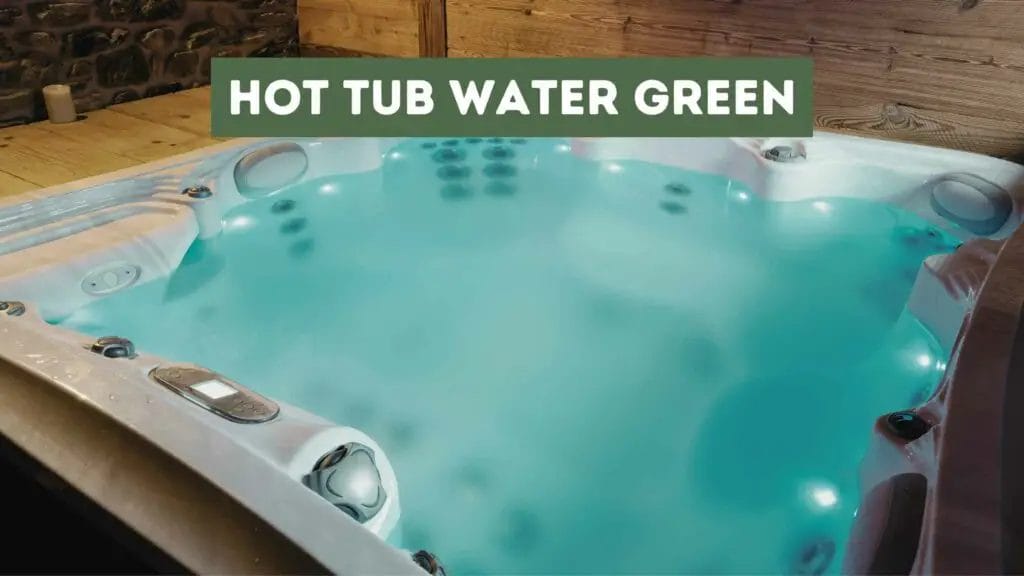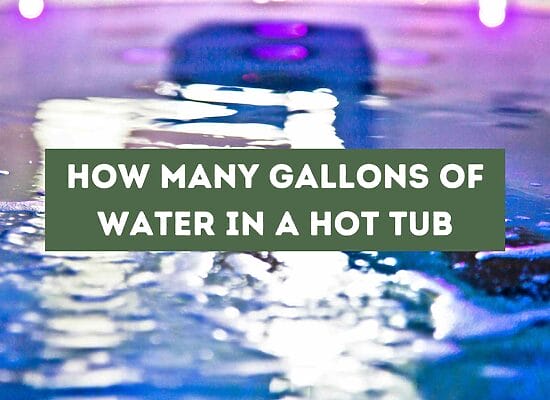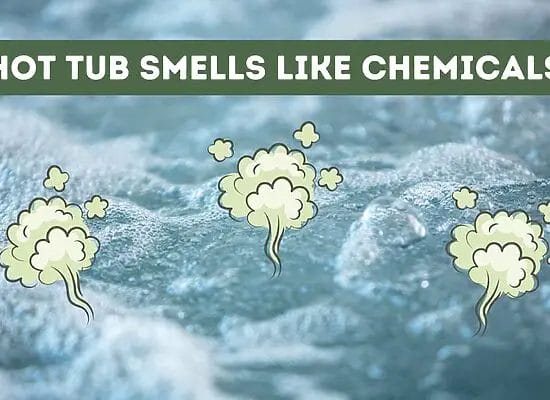
Do you own a hot tub and have noticed that the water has turned green? Don’t worry, this is a common problem that many hot tub owners face. Green water in a hot tub can be caused by a variety of factors, including algae growth, imbalanced pH levels, and mineral buildup. Understanding the causes of green hot tub water is crucial to fixing the problem and enjoying your hot tub once again.
Algae growth is one of the most common causes of green hot tub water. Algae require sunlight to grow, so it is typically found in outdoor pools. However, it can also infect hot tubs if there is adequate sunlight. Other causes of green hot tub water include imbalanced pH levels and mineral buildup. If left untreated, these issues can lead to more serious problems, such as damage to your hot tub’s equipment.
In the following paragraphs, we will explore the causes of green hot tub water and provide tips on how to fix the problem.
Key takeaways:
- Common Issue: Hot tub water turning green is a common problem for many hot tub owners.
- Causes: Green water can be caused by factors such as algae growth, imbalanced pH levels, and mineral buildup.
- Algae Growth: Algae growth is a common cause of green water. It thrives in warm water with inadequate sanitization or imbalanced pH and alkalinity levels.
- Chemical Imbalance: Green water can result from a chemical imbalance, where low pH levels cause copper to dissolve into the water. Proper pH adjustment and testing are necessary.
- Metal Contamination: Excessive metals like copper or iron in the water due to water source or filtration issues can lead to green water. Testing and metal sequestrants are solutions.
- Poor Filtration: Inadequate filtration can allow contaminants and algae to grow, leading to green water. Regular filter maintenance and clarifiers can help.
- Prevention and Maintenance: Regular cleaning, balanced water chemistry, proper filtration, and using a cover can prevent green water. Adding a metal remover can also help prevent mineral buildup.
Causes of Green Hot Tub Water
If you’ve noticed that your hot tub water is turning green, there are several reasons why this may be happening. In this section, we’ll go over the most common causes of green hot tub water and what you can do to fix it.
Algae Growth
One of the most common causes of green hot tub water is the growth of algae. Algae can grow in your hot tub if the water is not properly sanitized or if the pH and alkalinity levels are not balanced. Algae can appear as a slimy coating on the walls and floor of your hot tub and can be green, black, or mustard in color.
To prevent algae growth, it’s important to maintain consistent sanitization of your hot tub and regularly test the pH and alkalinity levels. You can also use algaecides to help prevent algae growth.
Chemical Imbalance
Another cause of green hot tub water is a chemical imbalance. If the pH and alkalinity levels are too low, the water can become too acidic and cause copper to dissolve from the heating element into the water. This can cause the water to turn green.
To fix a chemical imbalance, you’ll need to test the water and adjust the pH and alkalinity levels as needed. You can use test strips to test the water and add chemicals such as pH increaser or pH decreaser to adjust the levels.
Metal Contamination
Metal contamination is another common cause of green hot tub water. If there are excessive amounts of metals such as copper or iron in the water, it can cause the water to turn green. This can happen if the water source contains high levels of these metals or if the hot tub’s filtration system is not working properly.
To fix metal contamination, you’ll need to test the water for excessive metals and add a metal sequestrant to help prevent the metals from staining the hot tub. You may also need to clean or replace the hot tub’s filtration system.
Poor Filtration
Poor filtration can also contribute to green hot tub water. If the filtration system is not working properly, it can allow algae and other contaminants to grow in the water, causing it to turn green.
To fix poor filtration, you’ll need to clean or replace the hot tub’s filters regularly. You can also use a clarifier to help clear up the water.
Identifying Different Types of Algae
When it comes to hot tub maintenance, one of the most common issues is algae growth. Algae can take on different colors, and it’s important to identify which type of algae is present in your hot tub so that you can treat it properly. In this section, we’ll cover the three most common types of algae that you might encounter in your hot tub: green algae, yellow algae, and pink algae.
Green Algae
Green algae is the most common type of algae that you’ll find in a hot tub. It’s usually caused by a lack of proper sanitation or filtration. Green algae is easy to identify because it turns the water a murky green color. You may also notice slimy green patches on the walls or floor of your hot tub.
To get rid of green algae, you’ll need to shock your hot tub with a high dose of chlorine or another sanitizer. You should also clean your filters to make sure they’re working properly. Once the algae is gone, make sure to maintain proper sanitation and filtration to prevent it from coming back.
Yellow Algae
Yellow algae is less common than green algae, but it can still be a problem in some hot tubs. It’s usually caused by a lack of proper sanitation or by low levels of chlorine. Yellow algae is harder to spot than green algae because it can look like sand or dirt on the bottom of your hot tub.
To get rid of yellow algae, you’ll need to shock your hot tub with a high dose of chlorine or another sanitizer. You may also need to use an algaecide specifically designed to treat yellow algae. Make sure to clean your filters and maintain proper sanitation and filtration to prevent yellow algae from coming back.
Pink Algae
Pink algae is the least common type of algae that you’ll find in a hot tub. It’s caused by low levels of sanitizer and can be difficult to get rid of. Pink algae is easy to identify because it turns the water a pink or reddish color. You may also notice slimy pink patches on the walls or floor of your hot tub.
To get rid of pink algae, you’ll need to shock your hot tub with a high dose of chlorine or another sanitizer. You may also need to use an algaecide specifically designed to treat pink algae. Make sure to clean your filters and maintain proper sanitation and filtration to prevent pink algae from coming back.
Prevention and Maintenance
To keep your hot tub water crystal clear and prevent it from turning green, regular cleaning and maintenance are crucial. Here are some essential preventative measures to follow:
Regular Cleaning
Cleaning your hot tub regularly is the most effective way to prevent it from turning green. Scrub the sides of the tub with a non-abrasive cleaner to remove any dirt or debris that may have accumulated. Don’t forget to clean the cover as well, as it can harbor bacteria and other pollutants.
Balancing Water Chemistry
Maintaining proper water balance is crucial to prevent the growth of algae and other microorganisms that can cause green water. Test the water regularly and adjust the pH and alkalinity levels as needed. Use a sanitizer such as chlorine or bromine to keep the water clean and clear.
Proper Filtration
A good filtration system is essential to keep your hot tub water clean and clear. Make sure to clean or replace the filter regularly to prevent it from becoming clogged with debris. A clogged filter can reduce the effectiveness of the filtration system and lead to green water.
Cover Usage
Using a hot tub cover when the tub is not in use can help prevent the growth of algae and other microorganisms. A cover will also help to retain heat, reducing energy costs and extending the life of the hot tub. Make sure to clean the cover regularly to prevent the buildup of dirt and debris.
Pro Tip: Adding a metal remover to your hot tub can help prevent the buildup of minerals that can cause green water. Follow the manufacturer's instructions carefully and test the water regularly to ensure proper balance.
Treatment Methods
If you have green water in your hot tub, don’t worry, there are several treatment methods available to fix the issue. Here are some of the most effective methods:
Shock Treatment
Shocking the water is a common way to treat green water in a hot tub. It involves adding a large amount of sanitizer, such as chlorine or non-chlorine shock, to the water. This will kill any bacteria or algae that is causing the green color. You can shock the water once a week to keep it clean and clear.
Draining and Refilling
If shocking the water doesn’t work, you may need to drain and refill the hot tub. This is a more drastic solution, but it can be effective if the water is severely contaminated. Before draining the water, make sure to turn off the power and disconnect the hot tub from the electrical source. After draining the water, clean the hot tub thoroughly before refilling it with fresh water.
Cleaning the Filter
Another way to treat green water in a hot tub is to clean the filter. The filter cartridge can become clogged with debris and bacteria, which can lead to green water. Remove the filter cartridge and rinse it with a hose. Use a filter cleaner to remove any remaining debris. If the filter is damaged or worn out, replace it with a new one.
Using Sanitizers
Using sanitizers, such as chlorine or bromine, can help prevent green water in a hot tub. These chemicals kill bacteria and algae, keeping the water clean and clear. Make sure to follow the manufacturer’s instructions when using sanitizers and test the water regularly to ensure the correct levels are maintained.
Safety Measures and Considerations
When it comes to hot tub maintenance, safety is a top priority. Here are some important safety measures and considerations to keep in mind:
Dealing with Dangerous Metals
Hot tub water can contain dangerous metals such as copper and iron. These metals can cause staining on the hot tub surface and can even be harmful to your health. To prevent this, it is important to use a sequestering agent in your hot tub water. This agent will bind to the metals and prevent them from causing damage. It is also important to regularly test your hot tub water for metal content and adjust as necessary.
Understanding Water Contamination
Hot tub water can become contaminated in a number of ways. Bacteria, viruses, and other microorganisms can thrive in warm water, making it important to regularly sanitize your hot tub. It is also important to regularly test your hot tub water for contamination and adjust as necessary.
Preventing Algae Bloom
Algae can quickly take over a hot tub, turning the water green and making it unsafe to use. To prevent algae bloom, it is important to regularly shock your hot tub and maintain proper chemical levels. It is also important to keep your hot tub covered when not in use to prevent sunlight from promoting algae growth.
Pro Tip: To ensure your hot tub is safe and enjoyable to use, make sure to follow a regular maintenance schedule and test your water regularly. By taking these simple steps, you can keep your hot tub in top condition and enjoy it for years to come.
Common Issues and Solutions
If you are a hot tub owner, you may have encountered issues with your hot tub water turning green. In this section, we will discuss some common issues and solutions to help you keep your hot tub water clear and clean.
Green Tint Despite Regular Maintenance
If you notice a green tint to your hot tub water despite regular maintenance, it could be due to a pH imbalance. A low pH level means that the water is too acidic, which can cause copper to dissolve from the heating element into your spa water. To fix this issue, you can add a pH increaser to raise the pH level to the recommended range of 7.2-7.8.
Another possible cause of a green tint is an imbalance of sanitizer levels. Algae can thrive in warm water that hasn’t been treated with enough sanitizer, such as chlorine. You can shock your hot tub with a double dose of non-chlorine shock treatment and add regular sanitizer to help prevent algae growth.
Persistent Algae Growth
Algae growth is a common reason for having green hot tub water. Algae can easily grow in warm water that hasn’t been treated with enough sanitizer. To prevent algae growth, it is important to regularly clean and maintain your hot tub. You can use a hot tub cleaner to remove any buildup and sanitize the water.
If you have persistent algae growth, you may need to drain and refill your hot tub. Before refilling, make sure to clean the hot tub surfaces and filters thoroughly.
Unusual Water Colors
If your hot tub water is a color other than green, such as yellow, pink, or white, it could be due to a variety of reasons. Yellow water can be caused by high iron levels in the water, while pink water can be caused by bacteria growth. White water can be caused by air bubbles in the water, and brown water can be caused by rust buildup in the pipes.
To fix these issues, it is important to identify the root cause and take appropriate action. You may need to add a metal sequestrant to remove excess iron, shock the water with a sanitizer, or drain and refill the hot tub.
FAQ: Hot Tub Water Green
How do I fix green hot tub water?
Green hot tub water can be fixed by first checking the pH level of the water. If the pH level is too low, it can cause the water to turn green. Adjust the pH level to the recommended range of 7.2 to 7.8. If this doesn’t work, you can add a shock treatment or algaecide to the water. Be sure to follow the instructions on the product carefully. You can also clean the filter and drain and refill the hot tub.
Why is my hot tub water turning green?
Hot tub water can turn green due to algae growth, metal contamination, or a pH imbalance. Algae growth occurs when the water is not properly sanitized, or the filter is not cleaned regularly. Metal contamination can happen if the hot tub is filled with well water or if the water source contains high levels of metals. A pH imbalance can cause the water to turn green if the pH level is too low.
What causes green and smelly hot tub water?
Green and smelly hot tub water is usually caused by a buildup of bacteria and organic matter. This can happen if the hot tub is not properly sanitized or if the filter is not cleaned regularly. The smell is caused by the bacteria breaking down the organic matter in the water. To fix this issue, you can shock the water or use an algaecide to kill the bacteria. Be sure to clean the filter and, drain and refill the hot tub.
How can I prevent my hot tub water from turning green?
To prevent your hot tub water from turning green, you should maintain proper sanitization and pH levels. Test the water regularly and adjust the chemicals as needed. Clean the filter regularly and replace it as recommended by the manufacturer. Avoid using well water or water that contains high levels of metals. Also, be sure to shower before entering the hot tub to reduce the amount of organic matter in the water.
Can I still use my hot tub if the water is green?
It is not recommended to use your hot tub if the water is green. Green water is a sign of bacteria or algae growth, which can be harmful to your health. It can also damage the hot tub’s equipment. It is best to drain and refill the hot tub and properly sanitize the water before using it again.
What should I do if my hot tub water is greenish yellow?
Greenish yellow hot tub water is a sign of metal contamination. You can test the water for copper or iron using a water quality strip. If the levels are high, you can add a metal sequestrant to the water to bind the metals and prevent them from causing discoloration. You can also use a filter specifically designed to remove metals from the water. Be sure to avoid using well water or water that contains high levels of metals.












